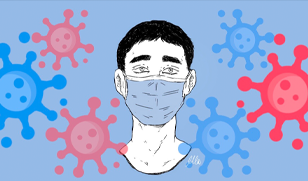Hemorrhagic fever is the reality of Iraq in terms of its nature and impact
Since 1979, Iraq has been one of the countries where the hemorrhagic fever virus (officially called Crimean-Congo hemorrhagic fever) is endemic, according to epidemiological reports issued by international health institutions. Since that time, waves of sporadic infections have occurred in Iraq, the latest of which are the cases that recently appeared in Dhi Qar and Najaf in early 2022.
Iraq owns a large number of livestock, cows, goats and sheep, and the profession of herding and selling meat and butchering is practiced by a large number of Iraqis, especially in rural places and governorates, where these animals are considered a major vector of the virus.
The cause of infection in hemorrhagic fever is a virus (Nairovirus) carried by tick insects and the disease was discovered for the first time in the city of Crimea in 1944 and then became the main cause of infection in the Congo in 1969, so it was given this common name (Crimean fever - Congo hemorrhagic fever).
Ways of infection and transmission
The bites of ticks are the main vector of the virus and the second vector is wild and domestic animals such as cows, goats, sheep and rabbits. The infection process is carried out by stings of insects or exposure to the blood of animals infected with the virus. The disease is transmitted from person to person through exposure to contaminated blood or fluids of the infected person. Cases of spread of the disease have been documented in hospitals as a result of neglect or absence of correct sterilization methods for medical equipment and tools, as well as the reuse of contaminated syringe needles or contamination of medical equipment and materials with the virus.
Symptoms and signs of the disease
The process of infection occurs suddenly and begins with the initial symptoms, which include headache, high fever, back, joint and stomach pain, as well as vomiting and other signs include redness of the eyes and face and the presence of red areas in the mouth and throat. As the disease progresses in the patient, the severity of symptoms increases to include large areas of red spots in the body and nosebleeds, as well as continuous bleeding in the places of injection of needles, and these signs occur on the fourth day of the injury and continue for two weeks.According to medical reports, the mortality rate among the injured in the hospital ranges between 9% to 50%.
Who is most likely to get sick?
Cattle and sheep herders, meat workers, slaughterhouses and butchers are the most vulnerable to the disease due to their continuous exposure to the blood of animals on a daily basis. As well as workers in the health sector, including doctors, veterinarians, nurses, laboratories and cleaners, are the most vulnerable to infection by exposing them to the risk of infection through exposure to fluids and blood of infected patients without using the approved prevention and protection methods. .
Treatment, vaccine and prevention methods
There is no cure for the disease and the available treatment is supportive therapy, which includes maintaining the balance of fluids in the body and oxygen and treating secondary infections that occur as a result of weakening the body's immunity during hemorrhagic fever. There is also no vaccine for this virus so far.
Farmers and workers in raising livestock and sheep must wear clothes that protect them from tick stings as well as use DEET, which is effective to repel ticks. In the health sector, especially hospitals, wearing medical gloves and protective clothing is very necessary in order to protect health workers and prevent transmission of the disease in hospitals. It is also a preventive method to avoid exposure to fluids and blood of animals and people who have shown signs of infection with the virus.
Statistical toll of injury in Iraq currently
The Iraqi Ministry of Health announced in late April that 20 cases of hemorrhagic fever and four deaths were confirmed, as well as there are suspected cases that have not yet been confirmed and these cases have been confirmed in the provinces of Dhi Qar and Najaf. Therefore, the southern regions of Iraq, especially the neighboring governorates of Dhi Qar and Najaf, are considered the most dangerous for the spread of the disease, and therefore the concerned authorities must take all necessary measures to prevent and control informal slaughter methods, as well as increase citizens' awareness about this disease, its seriousness and ways to prevent it.
Factors exacerbating the spread of the disease in Iraq
1- Frequent grazing of livestock, cows, sheep and goats in cities and their outskirts, selling and skinning them in primitive ways that do not observe health controls.
2- Neglect of the necessary prevention methods in government and private hospitals and weak control over them.
3- Neglect of medical instructions for proper sterilization methods for medical instruments, materials and devices used in surgical interventions in hospitals in Iraq.
4- Negligence and mismanagement of medical waste resulting from hospitals, which must be isolated and disposed of separately from household waste.
5- Exposure and easy access to medical waste such as needles, surgical tools and others by workers in digging waste in search of materials of material interest that can be resold again, as medical waste is disposed of in the same locations where household waste is disposed of, which exposes the lives of these workers to infection through contaminated needles.
6- The absence of awareness and health and preventive culture among the general public, especially those working in raising livestock and sheep, and their lack of awareness of the seriousness of contracting the disease, which may lead to death.
The World Health Organization (WHO), in collaboration with the Iraqi Ministry of Health, recently organized a three-day workshop to build the capacity of the rapid response teams working in the Iraqi Ministry of Health, which includes 42 doctors, veterinarians, laboratories, health workers and researchers in communicable diseases in more than 13 Iraqi governorates. For its part, the Iraqi government must activate and monitor the implementation of all precautionary and control measures to limit the spread of the disease among Iraqis, in addition to forming a rapid emergency committee from the ministries. concerned (Ministry of Health, Ministry of Agriculture, Ministry of Environment, Ministry of Interior, Media and Communications Commission) to take quick measures to help limit the spread of the disease. An important role falls on the shoulders of the Iraqi media in order to intensify propaganda campaigns and preventive directives and broadcast them through the media and communications to deliver them to the largest possible number in order to increase awareness and health culture among the public, which also helps to reduce the spread of the disease.
We must also not forget the role of social media (Facebook, Twitter, Instagram, Tik Tok, etc.) in delivering awareness and preventive messages to the general public, especially in southern Iraq, where the use of the Internet and social media is not limited to learners, but extends to all levels of society and has a very great impact if it is used in a way that does not cause panic and terror among people, it will deliver clear messages that carry useful information to people to protect them from infection from the disease and avoid its serious consequences, which can Up to death sometimes.







